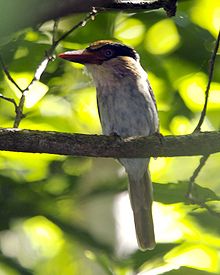- Lilac Kingfisher
-
Lilac Kingfisher 
Conservation status Scientific classification Kingdom: Animalia Phylum: Chordata Class: Aves Order: Coraciiformes Family: Halcyonidae Genus: Cittura
Kaup, 1848Species: C. cyanotis Binomial name Cittura cyanotis
(Temminck, 1824)The Lilac Kingfisher or Celebes Flat-billed Kingfisher, Cittura cyanotis, is a resident breeding bird in the lowlands of the Indonesia island of Sulawesi and the neighbouring Sangihe and Talaud Islands. It is the only member of the genus Cittura.
Contents
Description
The Lilac Kingfisher is 28 cm (11 inches) long. It has the typical kingfisher shape, with a short tail and long bill. The adult male of the nominate race, C. c. cyanotis, has a brown crown and back and rufous rump and tail. It has a blue eye mask, separated from the crown by a white line, and a pale lilac ruff of long stiffened ear covert feathers. The underparts are white and the wings are blue, separated by a white line from the brown back. The red bill is large and flattened. In flight, the underwings are white with a black wrist patch.
The female has a black, rather than blue, mask and upperwing coverts, and her supercilium is black, spotted with white. The juvenile resembles the adult, but is duller and browner with a grey-brown bill.
There are two or three subspecies;
- C. c. cyanotis, northern Sulawesi
- C. c. modesta, eastern and southeastern Sulawesi. This form, which is not recognised by some authorities, has less stiff ear coverts than nominate cyanotis. These feathers are lilac in the male and rufous in the female. The throat is rufous-lilac in both sexes.
- C. c. sanghirensis, Sangihe and Talaud islands. This subspecies is substantially larger and longer-billed than the nominate race. It has brighter, more rufous upperparts, a black forehead and mask, stiff, bright lilac ear coverts and upper breast, and a white chin.
The call of this large tree kingfisher is a rapid ku-ku-ku-ku.
The Lilac Kingfisher is unlikely to be confused with any other kingfishers in its range..
Behaviour
The Lilac Kingfisher is found in lowland rainforest and drier hill forest up to 1000 m altitude.
It perches motionless on a low branch watching for its prey, mainly large insects, on the ground below. Little else is known of the behaviour of this species, and no nests have been found.
Status
This species has a restricted range and fragmented distribution, and is uncommon, with no records from south Sulawesi. Lowland deforestation has been extensive in recent decades, and the loss of its habitat has led to Lilac Kingfisher being classed as near-threatened.
References
- BirdLife International
- Fry, Fry and Harris, Kingfishers, Bee-eaters and Rollers ISBN 0713652063
Categories:- IUCN Red List near threatened species
- Halcyonidae
Wikimedia Foundation. 2010.

